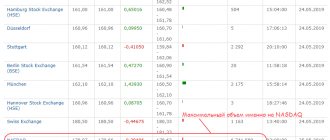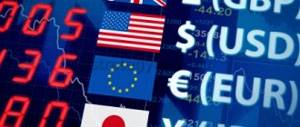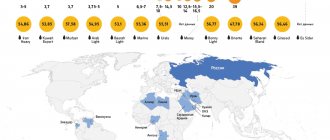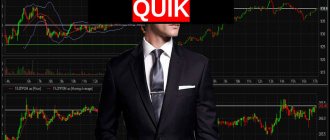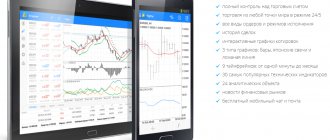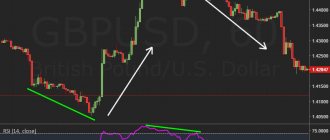Hello, dear friends! Many traders do not fully understand what a spread is in trading, much less understand how it is taken into account in trading. As a result, due to incorrectly set SL receive unnecessary losses, take profit may not work, although in theory it should have worked. And miracles happen with pending orders - either it will be executed when the chart does not reach it, or it will not work, although the candle has clearly reached the required level.
There is no manipulation on the part of the broker . The reason for these phenomena is the spread , and the fact that the order was executed at the wrong price is explained by its incorrect setting. I suggest you don’t make such mistakes again and figure out once and for all what spread is and how to work with it correctly .
Concept
Spread is one of the most important parameters that professional traders pay attention to in their trading. And beginners who are just exploring the market may not know this term at all. Having just become a little familiar with the market, some of them may ask: “What is a spread on the stock exchange in general, what is it and do I need it in trading?”
But by understanding this definition, you can understand some of the nuances of successful trading.
Translated from English, “spread” will sound like an expansion or a difference. To understand what it is, you need to imagine two counterparties on the exchange: the seller and the buyer.
Each of them submits an application to open a deal that is profitable for him. It is the gap between the best selling and buying prices that is called the stock spread.
To see the spread in the trading platform interface, you need to look into the so-called order book.
The order book is a dynamic table that changes in real time and displays purchase prices - Bid and sale prices - Ask.
The spread is the difference between these values, that is, between the highest purchase price and the lowest sale price.
Spread in the book of Brent oil futures
The gap between Bid and Ask exists in any book. Depending on the selected asset, this value may vary.
This price difference is always paid by the trader. And when planning his profit, he must take into account these inevitable expenses. In the case of liquid assets, the spread is often equal to the price increment.
For illiquid instruments, the difference in best prices can be very high.
As an example, we can analyze Gazprom shares. The screenshot below shows that the best purchase price is 182.47 rubles, and the best sale price is 182.5 rubles. That is, the spread is only 0.03 rubles.
If you study the shares of Qiwi, you will notice that in this case the spread is larger. It is already 1 ruble and often rises to the level of 2-6 rubles.
Although it cannot be said that Qiwi is an unreliable or illiquid company. However, its shares are a less liquid instrument in comparison with Gazprom securities.
Summary
The main thing you should take away from my article is:
- The broker will receive his profit on any transaction.
- The spread can be minimized by wisely choosing a company, account type, and currency pair. But reducing it to zero will not work . If it nevertheless decreases to near-zero values, then the broker will still receive his due from the commission.
Messages periodically appear on the network that there was a negative spread , but in most cases this is explained by a software malfunction. This can happen on a demo account with a very large amount of virtual deposit. In theory, this can also happen on a real account, when large-volume limit orders remain on one ECN platform, but on another they have already been sorted and the price has changed. But they are sorted out in a few ticks, and it is almost impossible to catch such a moment.
If you are just starting to trade, limit yourself to the majors and do not chase the number of transactions . In this case, the influence of the spread on the result will be reduced to a statistical error, and the profit will depend solely on your trading skills.
Surely you still have some questions after reading the material. They can and should be asked in the comments - I will be happy to answer them. And don’t forget to subscribe to my blog, you are guaranteed not to miss the release of new materials. With this, I bid you farewell for a moment. See you soon and good luck in your trading!
If you find an error in the text, please select a piece of text and press Ctrl+Enter. Thanks for helping my blog get better!
Description
An exchange spread is the difference between the best selling price and the best buying price for a particular asset on an exchange.
Spread in the trading terminal. Transactions on the stock exchange take place in the trading book. It shows the sale and purchase prices of a particular asset. In addition, at each price level, the investor sees the amount of the asset that they want to buy or sell at that price.
As a rule, sales prices are shown in red at the top. At the bottom in green are purchase prices.
Trading order book for Gazprom shares in the Quik web terminal. At the top are limit sell orders in red. Below are limit buy orders in green.
In the order book, orders are placed by investors who want to sell or buy at a certain price. Such orders are called limit orders. Investors who want to buy immediately at any price submit a market bid, or market order. Market orders are not visible in the trading order book.
A trade occurs when a market order meets a limit order. If the exchange only had limit orders or only market orders, investors would have to wait for the bid and ask prices to match.
The difference between the closest bid and bid prices is called the spread. The spread exists because the buyer and seller are not ready to give in to each other and are in no hurry to sell or buy.
On the stock market, spreads can be as large as several kopecks, as in shares of Gazprom or Sberbank. But there are spreads of several tens of rubles, as in shares of the Saratov Oil Refinery. The spread can be calculated not only in absolute values, but also as a percentage.
For example, the best price at which you can buy shares of the Saratov Oil Refinery is 13,950 RUR, and the best price at which you can sell them is 13,800 RUR. The spread is equal to:
(13,950 R - 13,800 R) / 13,950 R = 1.075%.
The best purchase price for shares of PJSC Gazprom is 232.41 RUR, and the best sale price is 232.38 RUR. The spread is:
(2232.41 R − 232.38 R) / 232.41 R = 0.013%.
The smaller the spread, the higher the liquidity of the asset.
To ensure transactions are completed quickly, there are market makers on the exchange. These are professional participants in the securities market. They enter into an agreement with the exchange and are obliged to maintain a certain spread in the trading order book. For this they receive preferences and rewards from the exchange. For example, their orders are executed first, and commissions are minimal. Market makers make money on the spread because they place limit orders to both buy and sell.
On the market
The bid is the monetary value that the buyer of a financial instrument is willing to pay.
Ask is the monetary value at which the seller is willing to sell it.
Spread is the difference between the bid and ask prices.
According to the conditions of market relations, when trading anything, the buyer must name the price at which he agrees to purchase (bid), and the seller – at which he can sell (ask). A striking example of how to properly structure these market relations is market trading at bazaars, when buyers name lower prices and sellers insist on higher prices. Since both parties need to complete a transaction, each of them
can only cede a certain limited amount, less or more of which will simply not be profitable for each of them.
So, if we return to the example of a bazaar, which in this discussion can be compared to an exchange, then the buyer and seller continue to bargain. In this case, the seller talks about a higher price, and the buyer talks about a lower price. If one or both parties do not agree to the terms of the transaction, the parties usually disagree. But we will now talk about a different outcome of events.
As trading progresses, sellers may slightly lower their prices, and buyers tend to lower their prices. So, in fact, the terms have not reached full agreement, but the prices offered by both sides are approaching a common point of contact. In other words, the difference between these prices, or spread, narrows. And only if buyers and sellers agree on the price that can be paid and at which the goods can be sold, the transaction can be considered automatically completed.
The above example may be familiar to anyone who has at least once tried to bargain at a market. However, few people sincerely understand that bazaar trading (considered by the masses to be the action of traders from the lowest strata of society) is in fact a fairly striking example of what pure market relations should be, which are a real standard for virtually all countries of the world.
On the exchange
Trading on the stock exchange follows a fairly similar scenario. A trader who wants to sell shares or other types of securities probably does not want to sell them at the average market price. In such situations, a trader who wants to buy shares does not express a desire to purchase them at market prices. In such cases
a trader who wants to buy can set his proposed price (bid), and one who sells can offer his (ask). It can be said that in order to complete a stock purchase and sale transaction on demand, traders must haggle.
Exchange trading occurs through negotiations and reduction of the spread, that is, the difference between the bid and ask prices. If the current market price of a stock is 1 ruble, then it is very likely that the ask price for it will be 1.02, and the bid price will be slightly lower - 0.97. Please note that the bid and ask prices are not much higher or lower than market prices. Accordingly, the bid indicator is lower by 3 kopecks, and the ask indicator is higher by 2.
If the market price of securities rises, the buyer understands that the market situation is changing the conditions for transactions, and can raise the bid, since the seller will have the right to ask for more. If current prices for securities or shares fall, then sellers, under market pressure, will be forced to ask for a lower ask, because buyers will not want to purchase them at an outdated, higher price.
Most often, the difference between the ask and bid prices is very small, and can amount to no more than a few kopecks, cents or other currency. Of course, traders have the right to avoid all the hassle and just conclude a purchase and sale transaction at market prices.
Each exchange instrument has a spread as a value; its size is set by the exchange, which is capable of changing it. The size of this parameter directly affects the liquidity of the market and traded instruments. And in order to prevent the market from crossing a certain liquidity threshold during the day (which could stop trading), the exchange is forced to create some restrictions as costs. And since the spread is a direct loss for traders, if there are too many costs, trading will take place much less actively. The exchange may expand this parameter both when there are too many purchases and when there are too many sales.
By the way, the size of the exchange spread can be measured not in monetary units, but in points.
The size of the spread on Forex varies significantly not only in the process of trading different currency pairs, but also depends on the brokers. Of course, in order to reduce costs, it is important to choose the most liquid currencies. But when choosing Forex dealing centers, it is also necessary to pay attention to the size of the spreads that are offered there. Despite the fact that it is quite stupid to choose brokers solely based on minimum spread indicators. If the costs are too low, this is a reason to think about the quality of services of this exchange, especially if we are talking about far from the most liquid currencies. In addition, it is worth remembering about the swap - the commission for moving a position overnight. In addition, trading is profitable only as long as the cost depends on the size, and some of the Forex brokers are ready to provide a spread return service.
Types of Spreads
Most brokers that offer their services online operate under the Market Maker model, meaning that they create and want to provide the highest possible liquidity. Market Maker brokers are different in that they often offer both floating and fixed spreads.
Floating spread
This option is probably the most frequently chosen by clients. Spreads vary depending on market conditions. For example, during times of high liquidity, when the European and American sessions overlap, the EURUSD spread is much lower than during the Asian session. In turn, spreads are wider during periods of low liquidity, that is, after the closure of financial centers in New York and before the opening of Asian markets. The spread can also be widened significantly before/during major market events.
Fixed spread
Spreads are kept at the same level, regardless of market conditions. In general, a fixed spread is wider than a floating spread because the broker has to take the risk of holding it throughout the day, even in markets with high volatility and low liquidity where interbank spreads are more likely to widen.
The choice between a floating or fixed spread depends primarily on your trading style. One of the most difficult elements to calculate when creating a trading strategy is the slippage that can occur when trading currencies.
For example, if you are using scalping strategies and are trying to make a small amount on each trade, you should deal exclusively with fixed spreads.
Short-term traders typically choose floating spreads due to their narrow range during periods of greatest liquidity in the market. They are also believed to reflect the true nature of the market. On the other hand, traders who base their decisions on fundamentals may choose a fixed spread, which will protect them from possible widening in the periods leading up to important macroeconomic events.
Some brokers offer tighter spreads to clients with larger accounts or those who trade more. Others offer the same spread for all categories of clients.
Comparison of spread sizes for TOP brokers in points
Are there any brokers without spread?
There are brokers that offer spread-free trading. Their earnings are in the commission they take from each transaction. It is easy to compare such brokers by comparing the commission sizes.
ATTENTION! A broker offering a spread-free account may set a high minimum deposit amount.
Here are several brokers offering accounts with a floating spread from 0:
- RoboForex in ECN-Pro and PRIME accounts
- Gerchik&Co for all accounts except Mini
Forex brokers with minimum spreads
If you choose not a commission, but a spread, then it is better that it be minimal. Here are a few brokers with minimal spreads:
| Broker name | Spread size |
| Alpari | floating - from 0.1 fixed - from 2.0 with commission floating - from 0 |
| Weltrade | floating with commission - from 0fixed - from 1.9floating - from 0.5 |
| RoboForex | floating - from 1.3 fixed - from 2.0 |
| Gerchik & Co | floating - from 0 |
Ask and Bid prices
The concept of Ask and Bid prices corresponds to the concept of purchase and sale prices.
Ask and Bid price
The Ask Price is the minimum price at which the seller agrees to sell. And the trader who chooses the Buy operation pays exactly the Ask price. For him, this is the purchase price.
They also write Ask, which translates from English as “to ask”, “to request”. This is the demand price - the amount that the buyer (demand representative) must spend on the product.
The Ask price is always higher.
Bid price is the maximum amount that a buyer is willing to pay for a currency pair. By clicking Sell, we pay this price.
Bid is translated from English as “offer”. Bid price - offer price. The trader, when selling, is the supply side.
The Bid price is always lower.
How to work
There is a spread in any order book of various exchange instruments. The ability to set large stop losses and take profits reduces its importance to a minimum. The situation is similar when trading on daily charts. But in day trading, the spread cannot be ignored.
Traders who prefer long-term trading are advised to use a floating spread. Its low value is a good moment for a player to enter the market. For medium time frames, the time of least volatility is of interest - the spread will remain in the minimum range.
When making transactions on the foreign exchange market, you should always take into account that the purchase price is slightly higher than that displayed on the chart. When a signal occurs, the reference point becomes not the signal, but the moment of purchase, therefore, when setting take profits, the take profit itself and the spread should be added to the moment of the signal. For the popular currency pair euro/dollar, the difference in prices is minimal, and the size of the spread can be neglected without consequences. When purchasing a less liquid currency, compliance with these conditions is mandatory. Stop loss is calculated similarly from the signal point.
When carrying out sales operations, stop losses are activated slightly before the price reaches this level. The reason for this is that the ask price is slightly higher than the market price. In this case, there is a high risk that the stop loss will be triggered at the time of sale due to the spread. Setting a stop loss at a higher level will help to avoid this: its value and spread are summed up, then one or two points are added depending on the specific currency pair. Take profits when selling are set below the market price level.
Options
Spread exists not only in stocks, but also in other exchange instruments. The spread exists in any “glass”. But if trading using the above-described system on highly liquid assets is quite difficult (an extremely high reaction is required), then on assets with slower behavior, the presence of a spread allows you to realize one of the main properties of the market - the ability to trade. There are a lot of assets (for example, among bonds), which may have sale prices, but there may be (almost or completely) no purchase prices. In this case (the bond meets the reliability criteria), you can set your purchase price in the “glass” and calmly wait to see whether it will be fulfilled or not. Also, this behavior can be used if there is a large spread in an asset - you can bargain and offer a slightly better price by placing your order as Bid or Ask. In this way, unused funds can be “stored” (money is also reserved for applications) in applications at attractive prices, so that if they are sold, profit is practically guaranteed.
Moreover, in addition to spreads in the “glasses” there are also calendar spreads. A calendar spread means the difference in prices of distant and nearby derivative instruments (often we are talking about futures) by expiration date, but for the same asset. Such spreads can be the result of both seasonal demand and a feature of the instrument. For example, dividend spreads between a stock and the corresponding futures. Because futures do not pay dividends, they are often traded as the stock price minus dividends. Calendar spreads can appear as a type of inefficiency during the evening session if there is strong news that moves the market during the evening session. The fact is that in the evening session, all activity is mainly focused on the futures that are closest in terms of expiration date, and further ones may be deprived of attention, which allows, if there is an increased difference in prices, to buy a cheaper and sell a more expensive asset, thereby receiving a financial difference and carrying out an arbitrage transaction.
Liquidity comes first
What is liquidity? This is the ability of a product to sell and buy well.
Let's take an example from life:
Which car do you think will be more liquid on the secondary market, Hyundai Solaris or Porsche Cayenne? Answer: Solaris. Let's look at the process of selling both cars through the eyes of the seller. There are more Korean cars on the market than German ones. The price of a Hyundai is much lower, which means there will be an order of magnitude more buyers for this brand. In other words, if you had both brands and decided to sell them, then it would be easier for you to find a buyer for Solaris at the right price. Cayenne will be sold for a long time at the price you need. And to sell it faster, you will have to greatly reduce the price, which will be unprofitable.
Now let's look at the same example, but through the eyes of the buyer. Let's say you have 500,000 rubles. for a used Solaris for his wife and 2 million rubles. for a used Caen for your loved one. There will be 100 Solaris at this price, of which it will be easier for you to choose a car that is not damaged and technically sound. But there will be about 20 Caen at this price, but upon closer examination, many of them will disappear, since they will either be broken, or repairs will require considerable investment, in other words, it will be much more difficult to find an unkilled Caen.
In the Forex market, the equivalent of Solaris is the euro/dollar pair. Every 3rd trader in the world (37%) trades this asset. This means that it has high liquidity and brings regular income to the broker. Therefore, the spread here is minimal.
Unlike the USD/ZAR pair, which in Forex is the equivalent of Caen (dollar/South African rand). Have you heard of the rand before? Now imagine how often they buy it, even if the name of the currency doesn’t tell you anything. It is clear why the spread here is 80–250 points (taking into account the low exchange rate, this is $60–190 with a volume of 1 lot). However, liquidity depends not only on the type of asset!
Influential factors include time of day, holidays and news releases. Let's remember the Swiss franc, which collapsed during the New Year holidays.
A real example. JP Morgan
1. Let’s calculate Interest Income on a 12-month rolling basis (TTM) for the financial year ending in December 2021:
Interest Income = $19,161 (Mar. 20) + $16,112 (Jun. 20) + $14,700 (Sep. 20) + $14,550 (Dec. 20) = $64,523
2. Let's calculate Interest Expenses on a 12-month rolling basis (TTM), for the financial year ending in December 2021:
Interest Expenses = $4722 (Mar. 20) + $2259 (Jun. 20) + $1687 (Sep. 20) + $1292 (Dec. 20) = $9960
3. Let’s calculate Average Earning Assets on a 12-month rolling basis (TTM) for the financial year ending in December 2021:
Average Earning Assets = ($2,465,649 (Mar. 20) + $2,819,689 (Jun. 20) + $2,874,974 (Sep. 20) + $2,955,646 (Dec. 20)) / 4 = $2,778,990
4. Define Net Interest Income:
Net Interest Margin = (Interest Income − Interest Expense) / Average Earning Assets = (64,523 − 9960) / 2,778,989 = 54,563 / 2,778,990 = 1.96%
5. Let's look at the dynamics. Until 2021, Net Interest Margin JPM was consistently above 2.40%.
Objectively. Banks' Net Interest Margin was under pressure in 2021; regulators, most notably the Fed, cut rates in hopes of strengthening the economy. The year turned out to be difficult; rising unemployment and a decline in production did not allow banks to play with high rates.
JP Morgan's NIM peaked in 2021 at 2.52%. At the end of 2019 - 2.46%. Throughout the 2021 financial year, JP Morgan's Net Interest Margin decreased steadily: 1Q - 2.37%, 4Q - 1.80%. So far, this is the lowest margin in at least 7 years.
Open an account and start trading CFDs on JP Morgan shares
Factors
- Liquidity (popularity) of a currency pair. In the most popular tandems, the spread size usually does not exceed 3-5 points, and when trading rare currencies, for example, the Canadian dollar or Swedish krona, this figure can reach 50 points or more.
- The current situation on the market, which in turn depends on economic and political factors in different countries and in the global community as a whole. Any “hot” news that can affect the rates of leading currencies significantly affects the size of the spread.
- The presence of affiliate programs, the participants of which receive compensation precisely due to the spread. By the way, the rapid growth of affiliate programs in this segment contributes to an increase in the size of this fee, which is an inevitable “headache” for any trader.
Spread or commission - 3 assets on which you can get rich or lose everything
Have you heard of zero spread accounts? Tempting stuff! Up close, everything turns out to be not so rosy, because the 0 spread points are compensated by the commission. And you pay the same amount, only it is called differently. But there are assets for which the commission and spread levels are strikingly different (you can save up to 50%):
- USD/CAD (Canadian dollar): on accounts with zero spread the commission is 2 points, and on traditional ones the spread is 4.
- XAG/USD (silver). This is the opposite option, when on accounts with zero spread the commission is 2 times higher than the traditional spread. Accordingly, the commission is 10 points versus 5 points of the spread.
- BTC/RUB (bitcoin/ruble): commission – 0.1%, spread – 0.8%.
In what cases is commission also more profitable than spread?
- If a trader trades pending orders. That is, it sets a condition to automatically open a deal when the price reaches a certain level. In this case, spread may cause the order to fail. For example, news is expected on the UK's exit from the EU. The trader assumes that the pound will fall against this background. But he knows that at such moments the servers are overloaded, and it is almost impossible to open an order. Or is at work, away from the computer. The way out of the situation is to trade on GBP/USD. According to it, if the price falls below 1.3398, a Sell order is opened. But there is still a spread of 8 points! And in fact, the trade will not open until GBP/USD reaches 1.3390. But the quote may not reach this level.
- Pips traders (scalpers) also prefer commissions. After all, if a trader makes a profit of 3–5 points, paying 4 for a spread is simply not profitable for him! Whereas the commission will be equal to 1 point.
- When trading intraday (when orders are not left overnight). Due to the spread, the price often does not reach the Take Profit or knocks down the Stop Loss. After all, this is a kind of “trailer” that the deal pulls behind it. But with the commission there is no such problem.
Formation using Forex as an example
Now let's look in detail at how the interaction between buyers and sellers occurs. Let’s say that at this particular moment in time there is an equilibrium, and the price has stopped at 75 rubles per euro. That is, demand completely selects all supply, their values at this point are equal. There are also those who are ready to sell and buy euros for the ruble at around 75.01 rubles per euro and similarly at 74.99. Around the price there is always an environment of such deferred interest, which comes into force as soon as the movement begins.
But, unfortunately, a single price for both purchase and supply is only possible if all participants interact directly, that is, buy and sell currency to each other. This is impossible, since there are always intermediaries - otherwise there is no way, it would be like a bazaar.
That is, there is a certain center that unites all participants and offers their requests for execution, but with prices moving in different directions. For example, Vasya wants to buy a dollar for a ruble, and Petya, on the contrary, wants to sell it. If they had contact with each other, they would do it at a price of, say, 70 rubles per dollar. But they do not communicate with each other, and this unifying center in the form of an exchange gives them such an opportunity, but with its own conditions. He will offer Vasya a dollar at 70.5 rubles, and buy from Petya at 69.5. A difference of one ruble appears - this will be the spread , which the exchange will take for itself for providing its services.
In this case, each participant will bear a burden of half a ruble. If these two decide to make a reverse transaction, then each of them will end up losing a ruble, and the exchange will receive an income of two. All this, of course, is conditional, but in general the mechanism with intermediaries works approximately like this, everyone adds their own price to the price.
Spreads for trading instruments are available in the “Market Watch” section
According to this principle a spread on Forex - the broker himself receives prices from the so-called liquidity providers. There is a list of offers for purchase and sale, they are all different from each other. The client is offered the best offer, that is, the values closest to the current price. This is the lowest price to buy and the highest price to sell. These two prices are called Bid and Ask respectively. They already fully reflect the interest of the broker, that is, these are the final prices for the trader.
Considering all of the above, we get a simple conclusion - when concluding a deal on Forex, a trader immediately gets into a small minus, since the purchase price differs from the sale price, and the deal, as we know, consists of two actions, regardless of the direction in which it is made. Therefore, the terminal always displays two quotes - for buying Ask, and for selling Bid. This applies to almost all instruments, except those that are sold at the same price, but there is a commission, which we will discuss later.
To add a window displaying the spread and trading in one click, you need to enable this function by right-clicking on the workspace and selecting the appropriate item.
What is swap
Swap (“swap”) is a daily interest accrued to or withdrawn from the trader’s account for the use of borrowed funds (credit - trading with leverage), which is conditionally placed on a deposit or withdrawn from it in favor of the broker if the trading position remains open at postponed past midnight. When trading Forex, the broker usually provides a table on the website with the amount of swaps, here is an example from Alpari:
